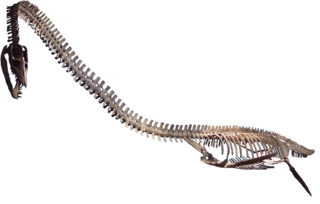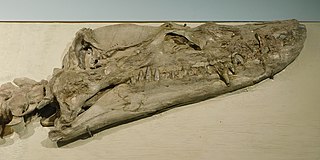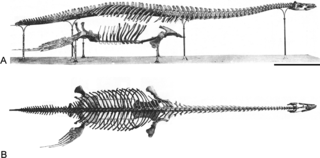
Elasmosaurus is a genus of plesiosaur that lived in North America during the Campanian stage of the Late Cretaceous period, about 80.5 million years ago. The first specimen was discovered in 1867 near Fort Wallace, Kansas, US, and was sent to the American paleontologist Edward Drinker Cope, who named it E. platyurus in 1868. The generic name means "thin-plate reptile", and the specific name means "flat-tailed". Cope originally reconstructed the skeleton of Elasmosaurus with the skull at the end of the tail, an error which was made light of by the paleontologist Othniel Charles Marsh, and became part of their "Bone Wars" rivalry. Only one incomplete Elasmosaurus skeleton is definitely known, consisting of a fragmentary skull, the spine, and the pectoral and pelvic girdles, and a single species is recognized today; other species are now considered invalid or have been moved to other genera.

Thalassomedon is a genus of plesiosaur, named by Welles in 1943.

Elasmosauridae is an extinct family of plesiosaurs, often called elasmosaurs. They had the longest necks of the plesiosaurs and existed from the Hauterivian to the Maastrichtian stages of the Cretaceous, and represented one of the two groups of plesiosaurs present at the end of the Cretaceous alongside Polycotylidae.

Mauisaurus is a dubious genus of plesiosaur that lived during the Late Cretaceous period in what is now New Zealand. Numerous specimens have been attributed to this genus in the past, but a 2017 paper restricts Mauisaurus to the lectotype and declares it a nomen dubium.

Woolungasaurus is a dubious genus of plesiosaur, an extinct marine reptile, belonging to the Elasmosauridae.

Scanisaurus is a dubious genus of plesiosaur that lived in what is now Sweden and Russia during the Campanian stage of the Late Cretaceous period. The name Scanisaurus means "Skåne lizard", Skåne being the southernmost province of Sweden, where a majority of the fossils referred to the genus have been recovered. The genus contains one species, S. nazarowi, described in 1911 by Nikolay Bogolyubov as a species of Cimoliasaurus based on a single vertebral centrum discovered near Orenburg, Russia.
Tuarangisaurus is an extinct genus of elasmosaurid known from New Zealand. The type and only known species is Tuarangisaurus keyesi, named by Wiffen and Moisley in 1986.

Styxosaurus is a genus of plesiosaur of the family Elasmosauridae. Styxosaurus lived during the Campanian age of the Cretaceous period. Three species are known: S. snowii, S. browni, and S. rezaci.

Aristonectes is an extinct genus of large elasmosaurid plesiosaurs that lived during the Maastrichtian stage of the Late Cretaceous. Two species are known, A. parvidens and A. quiriquinensis, whose fossil remains were discovered in what are now Patagonia and Antarctica. Throughout the 20th century, Aristonectes was a difficult animal for scientists to analyze due to poor fossil preparation, its relationships to other genera were uncertain. After subsequent revisions and discoveries carried out from the beginning of the 21st century, Aristonectes is now recognised as the type genus of the subfamily Aristonectinae, a lineage of elasmosaurids characterized by an enlarged skull and a reduced length of the neck.
Kaiwhekea is an extinct genus of plesiosaur from the Late Cretaceous of what is now New Zealand.

Brancasaurus is a genus of plesiosaur which lived in a freshwater lake in the Early Cretaceous of what is now North Rhine-Westphalia, Germany. With a long neck possessing vertebrae bearing distinctively-shaped "shark fin"-shaped neural spines, and a relatively small and pointed head, Brancasaurus is superficially similar to Elasmosaurus, albeit smaller in size at 3.26 metres (10.7 ft) in length as a subadult.

Alexandronectes is a genus of elasmosaurid plesiosaur, a type of long-necked marine reptile, that lived in the oceans of Late Cretaceous New Zealand. It contains one species, A. zealandiensis. Fossils of Alexandronectes were found in the Conway Formation of Canterbury, which can be dated to the Early Maastrichtian stage of the Cretaceous. Fossils of it were found around 1872 near the Waipara River, north of Christchurch, New Zealand.

This timeline of plesiosaur research is a chronologically ordered list of important fossil discoveries, controversies of interpretation, taxonomic revisions, and cultural portrayals of plesiosaurs, an order of marine reptiles that flourished during the Mesozoic Era. The first scientifically documented plesiosaur fossils were discovered during the early 19th century by Mary Anning. Plesiosaurs were actually discovered and described before dinosaurs. They were also among the first animals to be featured in artistic reconstructions of the ancient world, and therefore among the earliest prehistoric creatures to attract the attention of the lay public. Plesiosaurs were originally thought to be a kind of primitive transitional form between marine life and terrestrial reptiles. However, now plesiosaurs are recognized as highly derived marine reptiles descended from terrestrial ancestors.
Vegasaurus is an extinct genus of elasmosaurid plesiosaur known from the Late Cretaceous Snow Hill Island Formation of Vega Island, Antarctic Peninsula. It contains a single species, Vegasaurus molyi.

Kawanectes is a genus of elasmosaurid plesiosaur, a type of long-necked marine reptile, that lived in the marginal marine environment of Late Cretaceous Patagonia. It contains one species, K. lafquenianum, described in 2016 by O'Gorman.
Chubutinectes is an extinct genus of elasmosaurid plesiosaur from the Late Cretaceous La Colonia Formation of Argentina. The genus contains a single species, C. carmeloi, known from a partial skeleton and associated gastroliths.

"Satsuma-utsunomiya-ryu" is an undescribed plesiosaur known from Kyushu, Japan. This nickname is named after the former province name of the discovery site and the discoverer, Satoshi Utsunomiya. It is the oldest known elasmosaurid plesiosaur fossil in East Asia, dating back to approximately 100 million years ago. It is permanently exhibited at the Kagoshima Prefectural Museum.
Titanomachya is an extinct genus of titanosaurian sauropod dinosaur from the Late Cretaceous La Colonia Formation of Argentina. The genus contains a single species, T. gimenezi. It is a relatively small titanosaur, weighing around 7.8 tonnes.























